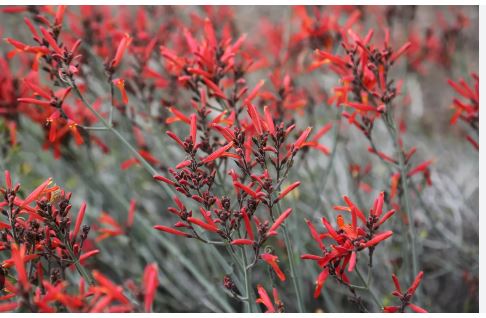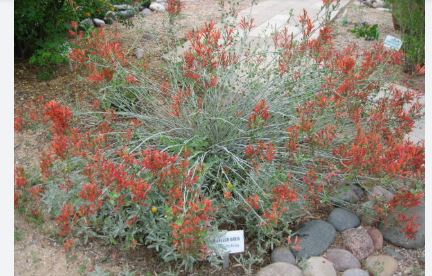
Chuparosa, scientifically known as Justicia californica, is a flowering shrub in the Acanthaceae family, which includes many tropical and subtropical plants with vibrant blooms. Previously classified under the genus Beloperone (as Beloperone californica), it has been reclassified into Justicia, a large genus of about 700 species. The name “californica” reflects its association with the southwestern United States, though its range extends beyond California. As a dicot, it shares the Acanthaceae family’s traits of opposite leaves and tubular flowers, aligning it with other pollinator-friendly shrubs like Anisacanthus species. Its taxonomic placement highlights its adaptation to arid environments, distinct from the family’s more tropical members.
Chuparosa is a deciduous to semi-evergreen shrub, growing 3–6 feet (0.9–1.8 meters) tall and up to 8 feet (2.4 meters) wide, with a rangy, open structure. Its arching, brittle stems are gray-green, often leafless during drought or cold, revealing a succulent-like quality. Leaves, when present, are small, heart-shaped, green, and about 0.5–1 inch (1.3–2.5 cm) long, dropping in response to stress. The plant’s hallmark is its tubular flowers, 1–1.5 inches (2.5–4 cm) long, typically bright red but occasionally yellow, with a two-lobed upper lip and three-lobed lower lip. These blooms appear in clusters from late fall to spring, peaking in winter in mild climates, and attract hummingbirds. Fruits are small, dry capsules, inconspicuous compared to the vivid flowers.
Chuparosa is native to the Sonoran Desert, spanning southern Arizona, southern California, southern Nevada, and northern Mexico, including Baja California and Sonora. It grows along washes, rocky slopes, and desert flats, typically below 3,000 feet (900 meters), where seasonal water is available. Its range represents the northernmost extent of the Justicia genus, thriving in hot, arid conditions with sporadic rainfall. Widely cultivated for its beauty and wildlife appeal, it has been introduced to desert gardens in the southwestern U.S., Australia, and other dry regions, but it remains most prevalent in its native Sonoran habitats, where it supports local ecosystems.
Justicia californica is hardy in USDA zones 8a–11, tolerating temperatures as low as 15°F (-9°C) for short periods, though it may die back to the ground in freezes, regrowing from roots in spring. It thrives in warm climates with temperatures between 50°F and 100°F (10°C–38°C), ideal for desert and subtropical regions. In zones 8a–8b, it benefits from winter protection, such as mulch or planting near walls for warmth. In colder zones (below 8a), it can be grown in containers and brought indoors during winter, adapting to indoor conditions with bright light and minimal watering.
Chuparosa is a standout in xeriscapes and desert gardens, valued for its vibrant winter-to-spring blooms and hummingbird attraction. Its open, airy habit suits informal, low-maintenance landscapes, where it adds color along borders, in rock gardens, or near washes. Planted singly, it serves as a focal point; in groups, it creates a natural screen or wildlife corridor. It thrives in tough conditions, tolerating reflected heat from walls or pavement, making it ideal for urban settings or poolside areas. In hummingbird gardens, it pairs well with other nectar-rich natives like desert honeysuckle. Its drought tolerance and minimal care needs—pruning only to shape—make it a sustainable choice, though it should be placed away from high-traffic paths due to its twiggy growth.

Cultivation of Chuparosa Plant
Cultivating the Chuparosa plant (Justicia californica) is straightforward due to its adaptability to arid conditions and low-maintenance requirements.
Light Requirements
Provide full sun for optimal growth and abundant flowering, with at least 6–8 hours of direct sunlight daily. Chuparosa thrives in bright, hot conditions typical of desert environments. In partial shade, it may produce fewer flowers and exhibit leggy growth, so prioritize sunny locations for best results.
Soil Preferences
Use well-draining, sandy, or gravelly soil with a pH of 6.0–8.0, mimicking its native desert habitat. It tolerates poor, rocky soils but benefits from slight organic matter like compost at planting. Avoid heavy clay soils, as they retain water and cause root rot; amend with sand or grit if necessary.
Watering Needs
Water sparingly once established, about every 2–3 weeks in summer, providing 1 inch (2.5 cm) of water. During establishment (first year), water weekly to promote root growth. In winter, reduce or stop watering, as the plant is drought-tolerant and may drop leaves to conserve moisture. Overwatering leads to weak growth or rot.
Temperature Range
Grow in USDA zones 8a–11, where temperatures range from 15°F to 100°F (-9°C to 38°C). It tolerates brief freezes but may die back in zones 8a–8b, regrowing from roots in spring. In colder zones, cultivate in pots and move indoors during winter, keeping temperatures above 50°F (10°C) for health.
Humidity Levels
Chuparosa prefers low humidity (20–40%), typical of desert climates. High humidity can promote fungal issues, so ensure good air circulation, especially in containers or crowded plantings. Indoor plants benefit from dry air in winter, avoiding misting to prevent leaf or stem diseases.
Container Selection
Choose pots with drainage holes to avoid water buildup. Terracotta or clay pots are ideal, promoting evaporation. Use a container at least 12–18 inches (30–45 cm) wide to accommodate the shrub’s spreading roots, ensuring stability for its twiggy structure. Repot every 2–3 years to refresh soil.
Fertilization
Apply a balanced, slow-release fertilizer (e.g., 10-10-10 NPK) once in early spring to support flowering. Alternatively, use a low-dose liquid fertilizer monthly during the growing season (spring–fall). Avoid over-fertilizing, as excess nutrients cause excessive foliage at the expense of blooms or weaken drought tolerance.
Pruning
Prune lightly in late winter or early spring to shape the plant and remove dead or crossing branches. Cut back leggy stems by one-third to encourage bushier growth, using clean shears. Avoid heavy pruning, as it stresses the plant and reduces flowering. Remove debris to prevent pests or fungal growth.
Propagation
Propagate via softwood cuttings or seeds. Take 4–6-inch (10–15 cm) cuttings in spring, dip in rooting hormone, and plant in a sandy mix; roots form in 4–6 weeks. Seeds, sown in spring at 70–80°F (21–27°C), germinate in 2–4 weeks but are less common due to slower growth. Keep cuttings moist until established.
Pest Control
Monitor for aphids, whiteflies, or spider mites, which may target new growth or stressed plants. Treat infestations with insecticidal soap or neem oil, applied in early morning to avoid leaf burn. Maintain proper watering and avoid overcrowding to reduce pest risks, as healthy plants are more resilient.
Repotting
Repot container-grown Chuparosa every 2–3 years in spring, or when roots outgrow the pot. Gently remove the plant, trim any dead roots, and replant in fresh, well-draining mix. Water lightly after repotting and provide shade for a week to minimize transplant shock, ensuring the pot has adequate drainage.
Winter Care
In zones 8a–8b, protect from frost by mulching the base with 2–3 inches (5–7.5 cm) of organic material or covering with frost cloth during cold snaps. If dieback occurs, cut back dead stems in spring to encourage regrowth. Indoor plants require minimal water and bright light during winter dormancy.
Common Issues
Address overwatering (yellowing leaves, root rot) by improving drainage and reducing frequency. Underwatering (leaf drop, shriveled stems) requires slight watering increases. Poor flowering may result from insufficient sun or excess nitrogen; adjust light exposure or fertilizer. Leaf scorch in extreme heat can be mitigated with afternoon shade.